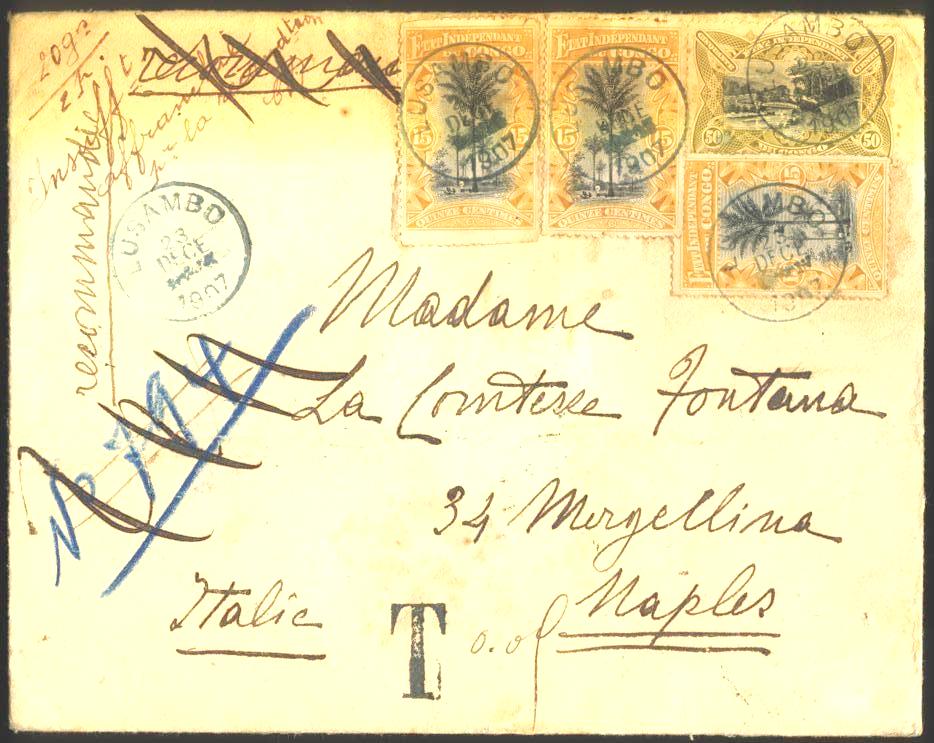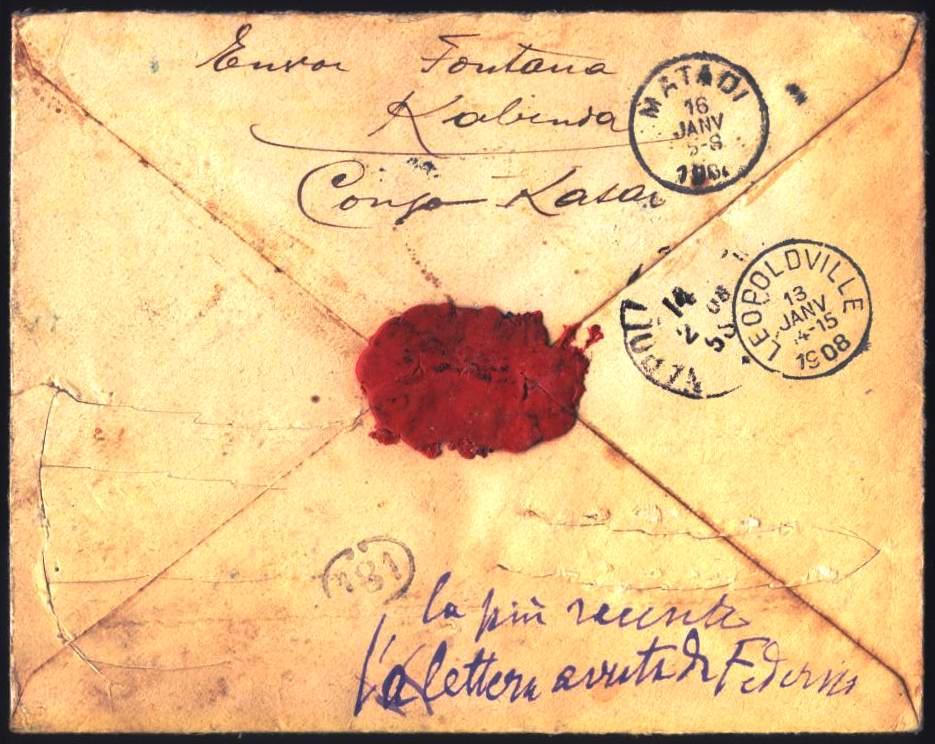Postal notes put manually by the postman on Belgian Congo mails
(generally with red ink)
The postman has in this post office, a lot of cancels for using on letters from his office or transiting by it. There are :
· circular post office cancel (name of office + date) for cancelling the stamps or for indicating a transit by the post office
· straight line cancel with name of post office for using on registered label or for cancelling the stamps transiting by the office and not yet cancelled
· some straight line cancels, framed or unframed such as DECEDE, RETOUR A L’ENVOYEUR, INCONNU, REBUT, PARTI SANS LAISSER D’ADRESSE, ….
BUT for some particular situations, there is NO cancel and the postman must indicate the problem on the cover by using his pen and a rek ink (generally – sometimes black ink)
I have tried to record here what we can find on our Belgian Congo mails.
1. « Retour à l’expéditeur / Les cartes seules /de l’Etat sont admises » (Return to sender, only the card of state are authorized)

Retour à l’expéditeur
Les cartes seules de l’Etat sont admises

This picture post card was sent from Coquihatville (Novenber 9th, 1898) to Diest / Belgium ; transit by Léopoldville on November 16th . Only the Postal Stationery issued by the Belgian Congo Post Office (and not the private picture post card ) are authorized at this postage rate of 15c. ; it was returned to the sender for a new franking.
2. carte postale incomplète (uncomplete postal card)
Before having a special framed straight line cancel (Boma Carte Incomplète) for indicating that the reply card was not attached at the demand card of dubble postal stationery, the postman has used a note (for indicating that the Post is not responsible of the missing reply, certainly detached by the sender and not stolen by a postman)
PARVENU BOMA SANS REPONSE » (arrived at Boma without reply) + initials


Demand card used from Leopoldville (Nov 16th, 1897) to Netherland ; transits by Boma (Nov 26th) and arrival on Dec 26th.
« PARVENU BOMA SANS FORMULAIRE REPONSE » (arrived at Boma without reply form) + signature


Reply card used from Leopoldville (Dec 8th, 1897) to Rotterdam / Netherlands where it arrived on Jan 18th, 1898 ; transit by Boma (Dec 20th) and Anvers (no date)
LEOPOLDVILLE “carte incomplète » (uncomplete card) + signature


Reply card used from Leopoldville (Aug 9th, 1898) to Lessines / Belgium where it arrived on Sept 14th ; transit by Boma (Aug 16th)
3. “à recommander” (to be registered)


Picture post card used from Basoko (Sept 30th, 1902) to Brussels (Nov 25th) ; transit by Léopoldville (Oct 24th). Last postage rate of Picture posta card at 50c (new postage rate perhaps not yet known at Basoko at this time). Rate = card (50c) + registration (50c) + ENREGISTRE (15c) = 1.15 fr. Blue straight line “ENREGISTRE” + with red ink “244” (“enregistrement” number) + note “à recommander” (to be registered) ; that has been done at Leopoldville where the “enregistre” was cancel by blue pencil cross and framed Recommandé” applied with number 1924 (in black ink).
4. Affranchissement insuffisant pour recommandation (insufficiently franked for registration)


Picture post card used from Pweto (May 3rd, 1903) to Berne / Switzerland where it arrived on Aug 8th . Rate = card (15c) + ENREGISTRE (15c) = 30c. ; At Leopoldville, the Enregistré was cancelled and a note applied in back ink “affranchissement insuffisant pour recommandation” ; in fact the sender should applied 50c more for registration for a total amount of 80c. and not 30c. ; the card has continued its travel as a normal post card.


Cover send from Coquihatville (Aug 15th, 1904) to Gand / Belgium where it arrived on Sept 27th; transit by Leopoldville (Aug 21th ). Calculation of rate : 17 (gram) = 2 (postal rate) = 2 x 50c = 1Fr. The sender has franked his cover for the registration but has badly estimated the weight. At Leo, the postman has put the note in red ink “affranchissement insuffisant pour la recommandation” and the cover has continued its travel as normal letter.
The insufficiently franking for registration is an African problem and for us, European, it’s very difficult to understand that because we go to the Post Office for a registered cover. But in Africa, the post office is in several cases at a long distance of the house and the sender will estimate the weight, put the franking on the cover, add some notes such as “Recommandé” and will give it at a boy who can bring it up to the post office. That explains why if the sender has made a mistake, the postman cannot register a cover insufficiently franked.
This cover illustrated also the next point :
5. indication of weight and postage rate

We can find on a lot of covers, in the right top corner the same note with black or red ink
17 = weight of 17 gram
2 = postage rate = 2 ports = letter with a rate between 15 and 29 grams


Lettre partie de Lusambo le 23 décembre 1907 à destination de Naples où elle parvint le 14 février 1908 ; passage par Léopoldville le 13 janvier et Matadi le 16 janvier.
Affranchi à 95c - manque 5c pour les 2 ports (20 gr) - griffe "T" et demande de taxation simple à 0,05 fr - demande de recommandation biffée et note manuscrite noire " insufft affranchi pr la recommandation"
6. CROIX à l’encre rouge - Annulation d’erreur postale
Il arrive que le postier fasse des erreurs dans l’emploi de ses dateurs postaux ; une fois que c’est fait, il n’est pas possible d’enlever la marque du cachet appliqué. Il ne reste plus qu’au malheureux postier d’annuler cette marque à l’aide d’une plume et d’encre rouge, en la marquant d’une croix.
Jusqu’aujourd’hui, je n’ai rencontré que deux types d’erreur corrigée de cette façon :
- Erreur de date dans le dateur – jour erroné
- Apposition par erreur du dateur sur le volet réponse d’un entier double alors que seul le volet demande devait être annulé.
JOUR ERRONE dans un dateur


Lettre recommandée (sous N° 602) partie de Leopoldville le 23 février 1904 à destination de Matadi où elle parvint le 25 février – dateur apposé à Matadi avec jour erroné du 24 février et annulé à la plume à l’encre rouge.
Tarif intérieur :
lettre d’un port (13g / 1p) 15c.
recommandation intérieure 25c. , soit 40c. au total